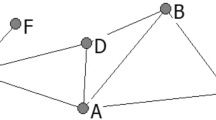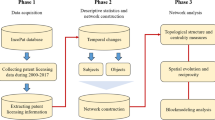Abstract
To investigate patterns of technology collaboration within the Chinese automobile industry, this study employs a unique dataset of patent applications that reveal a record of 64,938 collaborative relations in the industry during the period from 1985 to 2010. Our results indicate that over 60 % of the total collaborations were conducted after China entered the WTO. The invention and utility types of patents account for 98 % of the total collaborations throughout the sample period. Using a network analysis method, we find that the key differences between domestic enterprises collaborating with indigenous enterprises (DD collaboration) and with foreign firms (DF collaboration) are in patent types and technology domains. The DF network is also denser and more centralized than the DD network, although the amount of nodes and links of the DD network is greater than that of the DF collaboration network. The analysis and visualization of the collaboration networks and corresponding largest components reveal that a large number of domestic enterprises prefer to collaborate with top global automobile manufacturers. We also find that a number of universities have become key players in the collaborations among industry, universities and research institutes. This study provides a deeper understanding of technology collaborations from various perspectives and also highlights several avenues for future research.







Similar content being viewed by others
Notes
Although the R&D collaborations between foreign invested/owned firms can be an important topic, the focus of this paper is the DD, DF, and UIR R&D collaborations.
References
Abrami, R. M., Kirby, W. C., & McFarlan, F. W. (2014). Why China can’t innovate. Harvard Business Review, 92, 107–111.
Ahuja, G. (2000). Collaboration networks, structural holes, and innovation: A longitudinal study. Administrative Science Quarterly, 45, 425–455.
Allen, R. C. (1983). Collective invention. Journal of Economic Behavior & Organization, 4, 1–24.
Baum, J. A., Shipilov, A. V., & Rowley, T. J. (2003). Where do small worlds come from? Industrial and Corporate Change, 12, 697–725.
Becker, W., & Dietz, J. (2004). R&D cooperation and innovation activities of firms—Evidence for the German manufacturing industry. Research Policy, 33, 209–223.
Bierly, P. E., Damanpour, F., & Santoro, M. D. (2009). The application of external knowledge: Organizational conditions for exploration and exploitation. Journal of Management Studies, 46, 481–509.
Bloomberg. (2010). China ends US’s reign as largest auto market. http://www.bloomberg.com/apps/news?pid=newsarchive&sid=aE.x_r_l9NZE. Accessed 17 Sep 2013.
Borgatti, S. P., & Cross, R. (2003). A relational view of information seeking and learning in social networks. Management Science, 49, 432–445.
Borgatti, S. P., Everett, M. G., & Freeman, L. C. (2002). Ucinet for Windows: Software for social network analysis. Harvard, MA: Analytic Technologies.
Burt, R. S. (2004). Structural holes and good ideas. American Journal of Sociology, 110, 349–399.
Butts, C. T. (2006). Exact bounds for degree centralization. Social Networks, 28, 283–296.
Butts, C. T. (2008). Social network analysis: A methodological introduction. Asian Journal of Social Psychology, 11, 13–41.
Cao, C., Li, N., Li, X., & Liu, L. (2013). Reforming China’s S&T system. Science, 341, 460–462.
Cassiman, B., & Veugelers, R. (2006). In search of complementarity in innovation strategy: Internal R&D and external knowledge acquisition. Management Science, 52, 68–82.
Cattani, G., & Ferriani, S. (2008). A core/periphery perspective on individual creative performance: Social networks and cinematic achievements in the Hollywood film industry. Organization Science, 19, 824–844.
Chesbrough, H. (2003). Open innovation: The new imperative for creating and profiting from technology. Cambridge, MA: Harvard Business Press.
Chesbrough, H., & Crowther, A. K. (2006). Beyond high tech: Early adopters of open innovation in other industries. R&D Management, 36, 229–236.
Cheung, K.-Y., & Lin, P. (2004). Spillover effects of FDI on innovation in China: Evidence from the provincial data. China Economic Review, 15, 25–44.
Cho, T.-S., & Shih, H.-Y. (2011). Patent citation network analysis of core and emerging technologies in Taiwan: 1997–2008. Scientometrics, 89, 795–811.
Choi, S. B., Lee, S. H., & Williams, C. (2011). Ownership and firm innovation in a transition economy: Evidence from China. Research Policy, 40, 441–452.
Cohen, W. M., & Levinthal, D. A. (1989). Innovation and learning: the two faces of R & D. The Economic Journal, 99, 569–596.
Cowan, R., & Jonard, N. (2004). Network structure and the diffusion of knowledge. Journal of economic Dynamics and Control, 28, 1557–1575.
Dahl, M. S., & Pedersen, C. Ø. (2004). Knowledge flows through informal contacts in industrial clusters: myth or reality? Research Policy, 33, 1673–1686.
de Nooy, W., Mrvar, A., & Batagelj, V. (2005). Exploratory social network analysis with Pajek. New York: Cambridge University Press.
Dodgson, M. (2009). Asia’s national innovation systems: Institutional adaptability and rigidity in the face of global innovation challenges. Asia Pacific Journal of Management, 26, 589–609.
Doloreux, D., & Shearmur, R. (2012). Collaboration, information and the geography of innovation in knowledge intensive business services. Journal of Economic Geography, 12, 79–105.
Dunning, J. H. (1988). Open R&D and open innovation: exploring the phenomenon. The eclectic paradigm of international production: a restatement and some possible extensions, 19, 1–31.
Enkel, E., Gassmann, O., & Chesbrough, H. (2009). Open R&D and open innovation: exploring the phenomenon. R&D Management, 39, 311–316.
Eslami, H., Ebadi, A., & Schiffauerova, A. (2013). Effect of collaboration network structure on knowledge creation and technological performance: the case of biotechnology in Canada. Scientometrics, 97, 99–119.
Fabrizio, K. R. (2009). Absorptive capacity and the search for innovation. Research Policy, 38, 255–267.
Fleming, L., King, C., & Juda, A. I. (2007). Small worlds and regional innovation. Organization Science, 18, 938–954.
Gao, X., Guan, J., & Rousseau, R. (2011). Mapping collaborative knowledge production in China using patent co-inventorships. Scientometrics, 88, 343–362.
Glänzel, W. (2001). National characteristics in international scientific co-authorship relations. Scientometrics, 51, 69–115.
Glänzel, W., & Schubert, A. (2001). Double effort = double impact? A critical view at international co-authorship in chemistry. Scientometrics, 50, 199–214.
Goncalves, E., & Almeida, E. (2009). Innovation and spatial knowledge spillovers: evidence from Brazilian patent data. Regional Studies, 43, 513–528.
Gulati, R. (1999). Network location and learning: The influence of network resources and firm capabilities on alliance formation. Strategic Management Journal, 20, 397–420.
Handcock, M. S., Hunter, D. R., Butts, C. T., Goodreau, S. M., & Morris, M. (2008). statnet: Software tools for the representation, visualization, analysis and simulation of network data. Journal of Statistical Software, 24, 1548.
He, J., & Hosein Fallah, M. (2009). Is inventor network structure a predictor of cluster evolution? Technological Forecasting and Social Change, 76, 91–106.
Hong, W. (2008). Decline of the center: The decentralizing process of knowledge transfer of Chinese universities from 1985 to 2004. Research Policy, 37, 580–595.
Hong, W., & Su, Y.-S. (2013). The effect of institutional proximity in non-local university–industry collaborations: An analysis based on Chinese patent data. Research Policy, 42, 454–464.
Howells, J., Gagliardi, D., & Malik, K. (2008). The growth and management of R&D outsourcing: evidence from UK pharmaceuticals. R&D Management, 38, 205–219.
Inkpen, A. C., & Tsang, E. W. (2005). Social capital, networks, and knowledge transfer. Academy of Management Review, 30, 146–165.
Laursen, K., & Salter, A. (2006). Open for innovation: The role of openness in explaining innovation performance among UK manufacturing firms. Strategic Management Journal, 27, 131–150.
Li, X. (2011). Sources of external technology, absorptive capacity, and innovation capability in Chinese state-owned high-tech enterprises. World Development, 39, 1240–1248.
Li, X. (2012). Behind the recent surge of Chinese patenting: An institutional view. Research Policy, 41, 236–249.
Liu, W., & Dicken, P. (2006). Transnational corporations and ‘obligated embeddedness’: Foreign direct investment in China’s automobile industry. Environment and Planning A, 38, 1229.
Luo, Y., & Tung, R. L. (2007). International expansion of emerging market enterprises: A springboard perspective. Journal of International Business Studies, 38, 481–498.
Motohashi, K., & Yun, X. (2007). China’s innovation system reform and growing industry and science linkages. Research Policy, 36, 1251–1260.
Narula, R. (2004). R&D collaboration by SMEs: New opportunities and limitations in the face of globalisation. Technovation, 24, 153–161.
Newman, M. E. (2001). Scientific collaboration networks. I. Network construction and fundamental results. Physical Review E, 64, 016131.
Park, H. W., & Leydesdorff, L. (2010). Longitudinal trends in networks of university–industry–government relations in South Korea: The role of programmatic incentives. Research Policy, 39, 640–649.
Saxenian, A. (1994). Regional advantage: Culture and competition in Silicon Valley and Route 128. Cambridge: Harvard University Press.
Schartinger, D., Rammer, C., Fischer, M. M., & Fröhlich, J. (2002). Knowledge interactions between universities and industry in Austria: Sectoral patterns and determinants. Research Policy, 31, 303–328.
Schilling, M. A., & Phelps, C. C. (2007). Interfirm collaboration networks: The impact of large-scale network structure on firm innovation. Management Science, 53, 1113–1126.
Schmiele, A. (2012). Drivers for international innovation activities in developed and emerging countries. The Journal of Technology Transfer, 37, 98–123.
Schrader, S. (1991). Informal technology transfer between firms: Cooperation through information trading. Research Policy, 20, 153–170.
Schubert, A., & Glänzel, W. (2006). Cross-national preference in co-authorship, references and citations. Scientometrics, 69, 409–428.
Sorenson, O. (2005). Social networks and industrial geography, entrepreneurships, the new economy and public policy (pp. 55–69). New York: Springer.
Sun, P., Mellahi, K., & Thun, E. (2010). The dynamic value of MNE political embeddedness: The case of the Chinese automobile industry. Journal of International Business Studies, 41, 1161–1182.
Swar, B., & Khan, G. F. (2014). Mapping ICT knowledge infrastructure in South Asia. Scientometrics, 99, 117–137.
Uzzi, B. (1996). The sources and consequences of embeddedness for the economic performance of organizations: The network effect. American Sociological Review, 61, 674–698.
Von Hippel, E. (1987). Cooperation between rivals: informal know-how trading. Research Policy, 16, 291–302.
Von Hippel, E. (2007). The sources of innovation. New York: Oxford University Press.
Walter, J., Lechner, C., & Kellermanns, F. W. (2007). Knowledge transfer between and within alliance partners: Private versus collective benefits of social capital. Journal of Business Research, 60, 698–710.
Wang, H. (2003). Policy reforms and foreign direct investment. The case of the Chinese automobile industry. Journal of Economics and Business, 6, 287–314.
Wang, Y., Pan, X., Wang, X., Chen, J., Ning, L., & Qin, Y. (2013). Visualizing knowledge space: a case study of Chinese licensed technology, 2000–2012. Scientometrics, 98, 1935–1954.
Wang, Y., & Zhou, Z. (2013). The dual role of local sites in assisting firms with developing technological capabilities: Evidence from China. International Business Review, 22, 63–76.
Wasserman, S., & Faust, K. (1994). Social network analysis: Methods and applications. Cambridge: Cambridge University Press.
White, D. R., & Jorion, P. (1996). Kinship networks and discrete structure theory: Applications and implications. Social Networks, 18, 267–314.
Yam, R., Lo, W., Tang, E. P., & Lau, A. K. (2011). Analysis of sources of innovation, technological innovation capabilities, and performance: An empirical study of Hong Kong manufacturing industries. Research Policy, 40, 391–402.
Zaheer, A., & Soda, G. (2009). Network evolution: The origins of structural holes. Administrative Science Quarterly, 54, 1–31.
Zheng, J., Zhao, Z.-Y., Zhang, X., Chen, D.-Z., & Huang, M.-H. (2013). International collaboration development in nanotechnology: A perspective of patent network analysis. Scientometrics, 98, 683–702.
Zhou, P., Zhong, Y., & Yu, M. (2013). A bibliometric investigation on China–UK collaboration in food and agriculture. Scientometrics, 97, 267–285.
Zhu, W., & Guan, J. (2013). A bibliometric study of service innovation research: Based on complex network analysis. Scientometrics, 94, 1195–1216.
Acknowledgments
This research is funded by national Science Foundation of China (grant no.71302133; grant no.71233002), Youth Project of Ministry of Education, Humanities and Social Sciences Planning Funding (grant no.13YJC790154), and the Sichuan University’s Special Research Program for the Philosophy Social Science from the Subordinate Universities of Ministry of Education’s Basic Research Foundation (SKYB201302; SKX201004).
Author information
Authors and Affiliations
Corresponding author
Appendix
Rights and permissions
About this article
Cite this article
Wang, Y., Li, J., Ning, L. et al. Dynamic patterns of technology collaboration: a case study of the Chinese automobile industry, 1985–2010. Scientometrics 101, 663–683 (2014). https://doi.org/10.1007/s11192-014-1366-8
Received:
Published:
Issue Date:
DOI: https://doi.org/10.1007/s11192-014-1366-8




